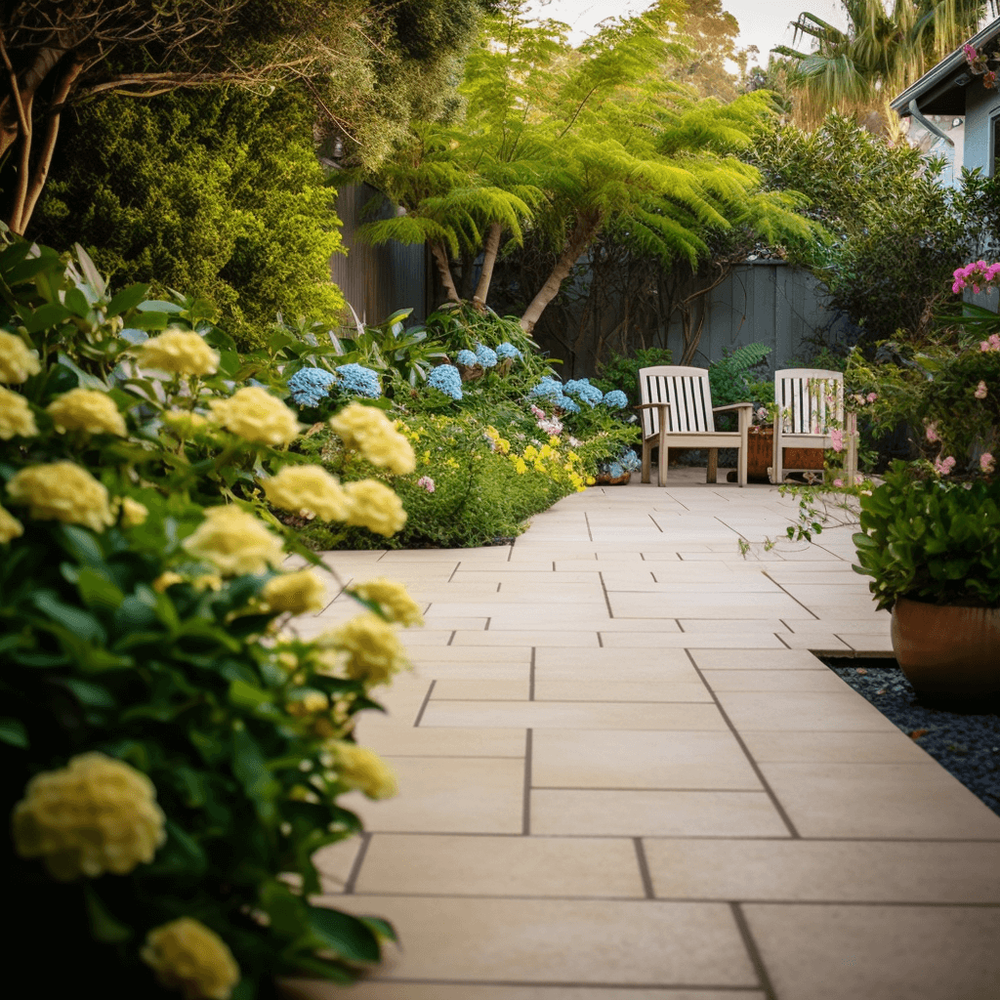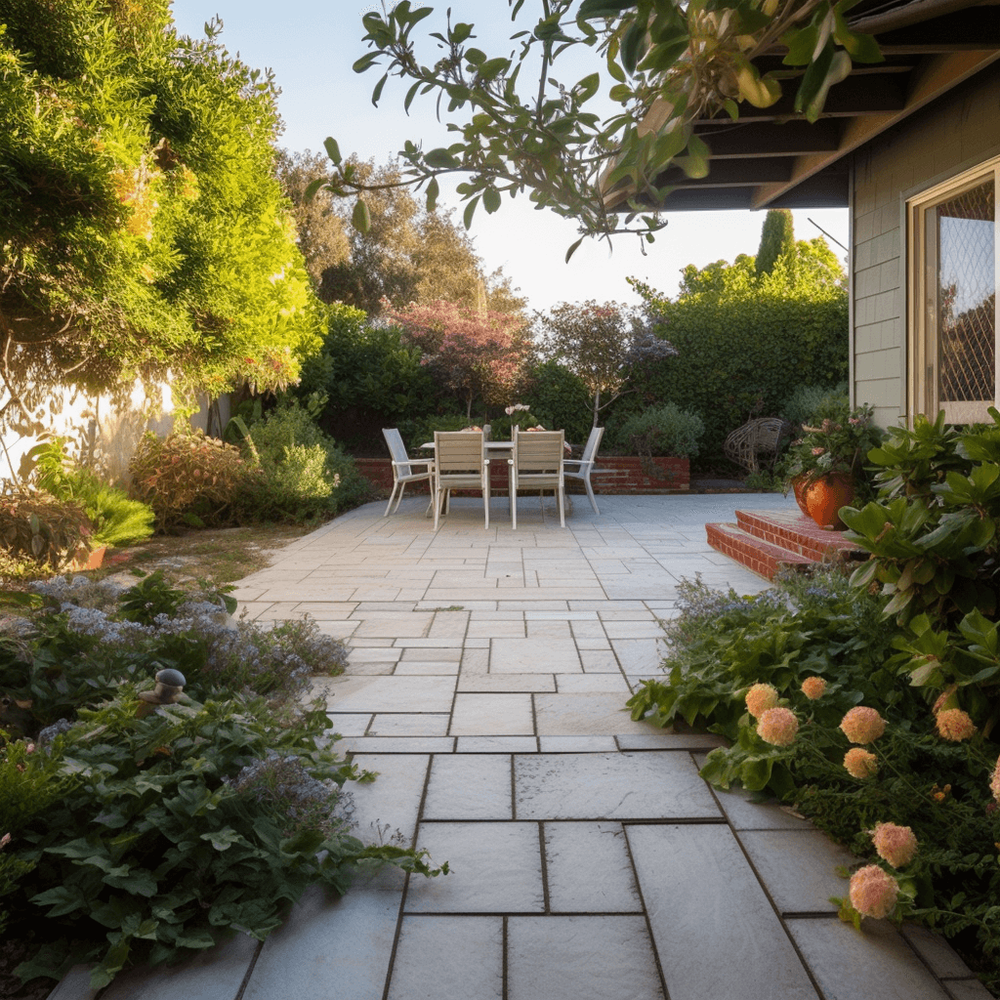
Are you considering upgrading your outdoor space with a durable and attractive rubber paver installation? If so, you’ve come to the right place! In this comprehensive step-by-step guide, we’ll walk you through the entire process of installing rubber pavers, sharing expert tips and tricks along the way.
n
Not only will these versatile interlocking tiles provide a safe and low-maintenance surface for your patio or walkway, but they also offer an eco-friendly alternative to traditional paving materials.
Key Takeaways
- n
- Rubber pavers offer durability and safety benefits, making them an ideal choice for outdoor flooring.
- Proper preparation of the surface is crucial to ensure a successful rubber paver installation, including measuring and marking the area, cleaning the surface thoroughly, and allowing it to dry completely.
- Essential tools for installing rubber pavers include adhesive, a trowel, measuring tape, a utility knife, and a level.
- Following this comprehensive step-by-step guide will enable you to create a beautiful outdoor space that is both safe and eco-friendly.
n
n
n
n
Benefits Of Rubber Pavers And Tools Needed For Installation
Rubber pavers offer durability and safety benefits, making them an excellent choice for outdoor flooring; to install rubber pavers, you will need adhesive, a trowel, measuring tape, a utility knife, level, and of course the pavers themselves.
Durability And Safety Benefits
One of the primary reasons why rubber pavers are an excellent choice for home landscaping projects in Arizona is their remarkable durability. These pavers can withstand harsh weather conditions, such as extreme heat and heavy rainfall, making them suitable for outdoor patios, walkways, and play areas.
n
In addition to durability, rubber pavers also offer significant safety benefits. The non-slip surface reduces the risk of slipping accidents during those infamous Arizona monsoon seasons when surfaces get wet.
n
Plus, their natural cushioning provides a softer landing for any accidental falls – perfect for households with young children or elderly family members who may be at greater risk for injury from falls.
Rubber Pavers
Rubber pavers are an excellent choice for those looking to create a durable and safe outdoor space. Not only do they provide a slip-resistant surface, but they are also environmentally friendly as they are made from recycled materials.
n
Additionally, rubber pavers come in various colors and patterns, allowing homeowners to create unique and visually appealing designs. Installing rubber pavers requires specific tools, such as adhesive, trowel, measuring tape, utility knife, level, and landscape pins.
Adhesive
Rubber pavers need to be held in place so that they don’t move or shift around. This is where adhesive comes into play. The adhesive is a waterproof glue that should be used to bind the rubber pavers together and prevent them from shifting over time.
n
It’s important to choose a high-quality adhesive as it can make or break your project. One of the best adhesives for rubber paver installation is polyurethane-based, which ensures better bonding and long-lasting durability even in hot Arizona summers.
Trowel
A trowel is an essential tool for installing rubber pavers. It’s used to spread the adhesive and smooth out any lumps or bumps before laying down the pavers. A notched trowel is recommended as it helps create even ridges on the adhesive, ensuring that each paver adheres securely to the surface beneath it.
n
Using a trowel may seem intimidating at first, but with practice, you’ll find that it’s relatively easy to use. Just remember to keep a firm grip on the handle and work in small sections at a time.
n
Another helpful tip is to clean your trowel frequently with warm water and soap to prevent adhesive buildup.
Measuring Tape
Before you start installing your rubber pavers, it’s important to have a measuring tape on hand. This will help ensure that you accurately measure the area where the pavers will be installed and that everything is lined up correctly.
n
A measuring tape can also come in handy when cutting edge pieces or trimming around obstacles like trees or poles.
n
Measuring tape is just one of the many tools needed for a successful rubber paver installation. With its durable and safe benefits, rubber pavers are an excellent choice for outdoor flooring solutions.
n
Whether it’s for landscaping purposes, patios, walkways, or even playgrounds – there are numerous advantages of using rubber pavers instead of other traditional materials such as concrete or brick.
Utility Knife
A utility knife is one of the essential tools you’ll need to install rubber pavers. This versatile tool can be used to make precise cuts in the pavers, especially when fitting them around curves or edges.
n
For best results, use a sharp blade and be sure to measure carefully before cutting. A dull blade can create uneven cuts or damage the integrity of the paver. Keeping your utility knife clean and replacing blades regularly will ensure smooth and easy cuts every time.
Level
Ensuring that your rubber paver installation is level is crucial to its success. Before laying down any pavers, it’s important to check that the surface you’ll be working with is free of bumps or dips.
n
This will ensure a smooth finish and prevent any tripping hazards.
n
Once you’ve cleared any obstacles, use a hand tamper or mechanical compactor to create a solid base for your rubber pavers. Compacting the soil creates an even surface and reduces the risk of settling over time.

Preparing For Installation
To prepare for installation, select a proper location and measure and mark the area, then clean the surface thoroughly and allow it to dry completely.
Choose The Right Location
Choosing the right location for your rubber paver installation is crucial for creating a safe and visually appealing space. When deciding where to install your rubber pavers, consider how the area will be used and its exposure to sunlight and moisture.
n
A well-chosen location can minimize wear and tear, reduce maintenance needs, and increase the longevity of your investment. For example, if you plan on installing rubber pavers near a pool or in an area with heavy foot traffic, choosing a non-slip surface is vital to prevent accidents.
n
Additionally, ensure that the location is level by using a measuring tape or level tool before beginning any installation work.
Measure And Mark The Area
Before starting your rubber paver installation, measure and mark the area you want to cover. This is a crucial step as it ensures that you purchase enough pavers for the project and also helps with planning and design.
n
Additionally, consider the traffic on the surface to determine how deep you need to excavate before installing your rubber pavers. A typical depth is four inches for pedestrian traffic areas and six inches for vehicular surfaces.
n
Following these steps will help ensure that you have proper preparation done before beginning your installation process, which will make laying down your rubber pavement much more manageable in general!
Clean The Surface Thoroughly
Cleaning the surface where you plan to install your rubber pavers is crucial for a successful installation. Make sure to remove any debris, dirt, or weeds from the area before starting.
n
Once you’ve cleared the area, give it a thorough cleaning with water and mild soap to ensure that no dust or dirt remains on the surface. Allow it to dry completely before proceeding with the installation process.
n
Preparing the surface properly will ensure that your rubber pavers adhere well and last longer without any shifting or sinking issues.
Allow Surface To Dry Completely
Before installing rubber pavers, it is important to ensure that the surface where they will be placed is completely dry. If there is any moisture present, it can cause the adhesive to fail and result in an unstable installation.
n
One helpful tip for ensuring a sufficiently dry surface is to check for any areas with standing water or damp spots. Depending on Arizona’s climate, these may require extra time to evaporate or may indicate drainage issues that need to be addressed before continuing with the installation.

Step-by-Step Guide To Installing Rubber Pavers
Learn how to lay down landscape fabric, align and secure pavers, fill in spaces with sand, apply adhesive, and more in this comprehensive guide to installing rubber pavers.
n
With these step-by-step instructions, you’ll be able to create a beautiful and durable outdoor space that’s safe for the whole family.
Lay Down Landscape Fabric
Before installing your rubber pavers, it’s important to lay down landscape fabric. This will help prevent weeds from growing under the pavers and will keep the installation looking tidy for years to come.
n
The fabric should be laid over the entire area where you plan to install your pavers.
n
In addition to preventing weed growth, landscape fabric also helps with drainage and prevents soil erosion from rainwater runoff.
Lay The First Paver And Align it Properly
Once you have prepared the surface, it is time to lay down the first rubber paver. This step is crucial, as it sets the foundation for the rest of your installation. Make sure that your first paver is aligned properly before proceeding with laying down the others.
n
To align your first paver correctly, begin by placing it in one corner of your designated area. Work outward from this point, ensuring that each subsequent paver lines up precisely with its neighbor.
n
Remember that proper alignment is critical for safety reasons as well as aesthetics.
Add The Rest Of The Pavers
Once the first paver is set in place and properly aligned, it’s time to add the rest of the pavers. Use a rubber mallet to gently tap each paver into place, ensuring they are secure and level with one another.
n
If you need to cut any of the pavers to fit tight spaces or edges, use a utility knife or saw blade designed for cutting rubber. Be sure to keep the area clean and free of debris as you work your way through this step.
n
Once all of the pavers have been added, it’s important to secure them in place with landscape pins or similar materials.
n
Remember that each step is critical for a successful installation – take your time and follow each step carefully according to the best practices outlined in this guide for optimal results!
Cut Pavers To Fit The Edges
Cutting rubber pavers to fit the edges of your installation area can be one of the trickiest parts of the process. It’s important to measure twice and cut once, as they say, to avoid costly mistakes or wasted material.
n
Using a utility knife or circular saw with a fine-toothed blade, take your time making precise cuts that fit snugly against corners and obstacles.
n
To ensure an even look throughout your entire project, consider using edge restraints made specifically for rubber pavers. These will help hold everything in place while also providing a clean finish that looks professional.
Secure The Pavers With Landscape Pins
Once you have laid down all the rubber pavers, it’s time to secure them in place using landscape pins. These pins are essential for keeping your project intact and protecting against any shifting or movement over time.
n
The best thing about these pins is that they can blend well with your yard’s landscaping- making them virtually invisible once installed.
n
Using landscape pins ensures that your rubber pavers stay put even during harsh weather conditions such as heavy rain and windstorms. Without this crucial step, you risk having your beautifully placed patio tiles slip out of position and ruin the look you are going for.
n
Plus, with their discrete appearance, they will not be an eyesore to detract from your overall design scheme.
Fill In The Spaces With Sand
After laying down your rubber pavers, you’ll need to fill in the spaces between them with sand. This step is critical for proper drainage and stability. Pour the sand over the pavers, making sure it fills every gap.
n
If you’re worried about weeds popping up between your pavers, consider using polymeric sand instead of regular sand. It hardens when water is added, creating a tight bond that keeps weeds at bay.
Apply Adhesive
After laying down the rubber pavers and filling in the spaces with sand, it’s time to apply adhesive. This is a crucial step that will ensure your pavers stay in place for years to come.
n
Be sure to use a waterproof adhesive that’s compatible with rubber pavers and follow the manufacturer’s instructions closely.
n
To keep yourself from getting stuck mid-installation, consider having an extra set of hands help you during this step. A friend or family member can hold the pavers in place while you apply the adhesive, making for a smooth and stress-free process.

Tips And Tricks For Successful Installation
Use a rubber mallet to secure connections, keep pavers clean and free of debris, allow for proper drainage, consider color and pattern options, and use a rubber sealant for added protection.
Use A Rubber Mallet For Secure Connections
To ensure that your rubber pavers stay in place, it is essential to use a rubber mallet for secure connections. The flexible nature of the rubber allows the pavers to connect smoothly, but they still need a little help staying together.
n
If you don’t use a rubber mallet for installation, there’s an increased risk of damaging the pavers or causing them to move out of position. Remember always to keep your work area free of debris and ensure proper drainage.
n
When finished using the mallets, store them safely away from children and pets since they can pose a hazard if left out in the open.
Keep Pavers Clean And Free Of Debris
Maintaining clean and debris-free rubber pavers is crucial for their longevity and aesthetic appeal. To keep your pavers looking great, sweep off any dirt or debris regularly with a broom or leaf blower.
n
Additionally, consider investing in landscape fabric to prevent any weeds from growing up between the pavers.
Allow For Proper Drainage
Proper drainage is vital for any successful rubber paver installation. Without proper drainage, the pavers may become unstable and potentially hazardous. It’s important to ensure that water has a place to go when it rains or when irrigation is used in the area where the pavers are installed.
n
To allow for proper drainage, one option is to install a slight slope in the surface underneath the pavers. Another option is to incorporate drainage systems like French drains or catch basins into the landscape design.
Consider Color And Pattern Options
When it comes to installing rubber pavers, choosing the right color and pattern can really enhance the overall look of your outdoor space. Rubber pavers come in a variety of colors and patterns, from natural stone looks to vibrant hues.
n
Consider the colors that complement your home’s exterior or create contrast for added visual interest. Additionally, you can play with different patterns and shapes to create unique designs like checkerboards or herringbone layouts.
Use A Rubber Sealant For Added Protection
Adding a rubber sealant to your newly installed Rubber Pavers is an excellent way of adding extra protection and enhancing their longevity. The sealant helps protect the pavers against adverse weather conditions, water damage, UV rays, oil spills, and stains.
n
At installation time, you can apply a layer of waterproof adhesive after filling in the spaces with sand before sealing up with brand-specific rubber sealant. This final step provides added strength and durability that will ensure that your investment lasts longer without any compromising on its safety benefits or aesthetics.
Conclusion.
Congratulations! You are now equipped with the knowledge and skills to install rubber pavers like a pro! With this step-by-step guide, you can create a beautiful outdoor space that is both safe and durable.
n
Remember to follow each step carefully, use the right tools, and keep these tips and tricks in mind for a successful installation. From choosing the right location to applying adhesive, every detail matters when it comes to creating an outstanding walkway or patio.
nn

